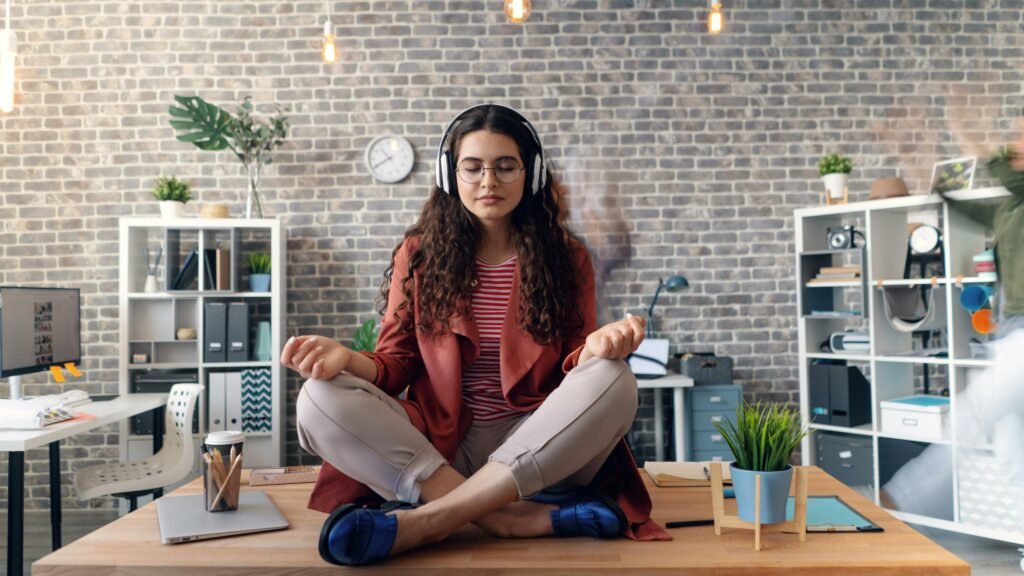
Overview of Grounding Meditation
Grounding meditation is an essential practice in today’s hectic world, offering a way to stabilize your thoughts and emotions amid daily stressors.
This form of meditation focuses on establishing a connection with the present moment, allowing you to break free from the whirlwind of worries and distractions that often occupy your mind.
By integrating grounding meditation into your routine, you can cultivate a sense of tranquility and clarity, making it easier to navigate life’s challenges.
One of the key elements of grounding meditation is its accessibility.
Whether you have just a few minutes or a longer period to devote to your practice, you can tailor your meditation to fit your schedule.
For example, a quick 3-minute meditation can be as effective in bringing you back to a centered state as a more extended session.
The flexibility of grounding meditation makes it an ideal practice for busy individuals seeking to incorporate mindfulness into their daily lives.
At its core, grounding meditation is about connecting with your body and the environment around you.
This connection can be achieved through various techniques, each designed to anchor your awareness in the present moment.
Simple practices like deep breathing, where you focus on the rhythm and sensation of each breath, can serve as a powerful anchor.
Another technique is to engage in a body scan, mentally noting the sensations in each part of your body.
These practices help divert your attention from racing thoughts and ground you in your physical experience.
The benefits of grounding meditation extend beyond immediate stress relief.
Regular practice can lead to long-term improvements in emotional regulation, resilience, and overall well-being.
By fostering a habit of mindfulness, you become better equipped to handle stress and maintain mental clarity.
Grounding meditation can also improve your relationship with yourself, encouraging self-compassion and reducing tendencies to engage in avoidance behaviors.
Incorporating elements of nature into your grounding meditation can deepen your practice.
Whether you’re sitting in a park, your backyard, or simply visualizing natural surroundings, the presence of nature can enhance your sense of groundedness.
The sights, sounds, and sensations of the natural world can serve as powerful anchors, helping you to feel more connected and present.
Grounding meditation is also highly adaptable to different preferences and needs.
For those who find stillness challenging, incorporating movement can be beneficial.
Practices like yoga or tai chi, which combine physical postures with mindful breathing, offer a dynamic way to achieve grounding.
Alternatively, walking meditation, where you focus on each step and the sensations it brings, can integrate mindfulness into your daily activities.
By understanding the principles and techniques of grounding meditation, you can develop a practice that fits seamlessly into your life.
Whether you’re dealing with a particularly stressful day or looking to establish a routine that promotes mental clarity, grounding meditation offers tools to help you stay centered and balanced.
Initial Techniques to Begin With

For those new to meditation, starting with simple techniques can make the practice more approachable.
One of the most effective methods is a breathing exercise.
By focusing on your breath, you can anchor your mind and body, making it a perfect 3-minute meditation.
Another introductory practice is body scan meditation, where you systematically relax each part of your body, from head to toe.
Breathing exercises are straightforward yet highly effective.
To begin, sit in a comfortable position and close your eyes.
Take a deep breath in through your nose, hold it for a moment, and then slowly exhale through your mouth.
As you breathe, focus on the sensation of the air entering and leaving your body.
Feel the rise and fall of your chest and abdomen with each breath.
This simple act of paying attention to your breath can quickly bring you to a more centered and relaxed state.
Body scan meditation is another excellent technique for beginners.
This practice involves mentally scanning your body for areas of tension and consciously relaxing them.
Start by lying down in a comfortable position. Close your eyes and take a few deep breaths to settle in.
Begin the scan at the top of your head, noticing any sensations or areas of tension.
Gradually move your focus down your body, part by part, until you reach your toes.
As you scan each area, imagine releasing any tightness or discomfort.
This technique not only helps you become more aware of your physical state but also encourages a deep sense of relaxation.
For those who prefer a more guided experience, using a meditation app or listening to a guided meditation can be incredibly helpful.
These resources often provide step-by-step instructions and can make it easier to stay focused. Guided meditations can range from short 3-minute sessions to longer practices, allowing you to choose what fits best into your schedule.
Mantras can also serve as a useful tool for grounding meditation.
A mantra is a word or phrase that you repeat silently to yourself during meditation.
This repetition helps to focus your mind and can create a sense of calm.
Choose a word or phrase that resonates with you, such as “peace,” “calm,” or “I am present.”
As you meditate, repeat your mantra in sync with your breath, allowing it to anchor your thoughts and bring you into the present moment.
Integrating these simple techniques into your daily routine can lay a strong foundation for a consistent meditation practice.
Grounding Practices Rooted in Nature

Meditating outdoors can significantly enrich your grounding meditation practice by providing a direct connection to the natural world.
Being in a park, garden, or even your backyard allows you to experience the calming effects of nature.
The gentle rustling of leaves, the chirping of birds, and the feeling of the earth beneath you can enhance your sense of presence and tranquility.
Incorporating natural elements into your meditation can deepen your connection to the environment and enhance your practice.
For example, you can use a small stone or a plant as a focal point during your meditation.
Holding a smooth stone in your hand can provide a tactile anchor, reminding you of the earth’s stability and grounding energy.
Similarly, focusing on the intricate details of a plant—its leaves, texture, and even its scent—can serve as a natural anchor for your awareness.
Walking meditation is another excellent way to integrate nature into your grounding practice.
Choose a natural setting like a trail, park, or beach where you can walk slowly and mindfully.
As you walk, pay attention to each step and the sensations it brings.
Feel the ground under your feet, notice the rhythm of your steps, and observe the natural surroundings.
This practice not only grounds you but also makes you more aware of your body and environment.
For a more immersive experience, consider meditating near a body of water.
The soothing sounds of flowing water can serve as a natural soundtrack for your meditation, helping to calm your mind and anchor your thoughts.
Whether it’s a river, lake, or even a small fountain, the presence of water can enhance your sense of tranquility and groundedness.
Another technique is to engage in earthing, which involves direct skin contact with the earth.
Find a safe and comfortable spot where you can sit or lie down on the ground.
The physical connection with the earth can help you feel more anchored and stable.
Some people find that walking barefoot on grass or sand enhances their grounding experience, as it allows for a more direct connection with the earth.
Nature-based visualizations can also be a powerful addition to your grounding meditation.
Close your eyes and imagine a calming natural scene, such as a forest, beach, or meadow.
Envision yourself immersed in this environment, feeling the warmth of the sun, the coolness of the breeze, and the solidity of the ground beneath you.
These visualizations can create a mental sanctuary, helping you to feel more centered and at peace.
Incorporating these nature-based techniques into your grounding meditation practice can offer a refreshing and enriching experience, helping you to stay present and connected to the world around you.
Visualizations to Achieve Inner Harmony

Visualizations can be a powerful component of grounding meditation, helping you to achieve inner harmony by mentally transporting you to serene and calming environments.
Guided imagery, for instance, involves creating vivid mental pictures of peaceful settings that can soothe your mind and body.
Picture a tranquil beach with waves gently lapping at the shore, or a quiet forest where the only sounds are the rustling leaves and distant birdsong.
As you imagine these scenes, try to engage all your senses: feel the warmth of the sun, hear the soft sounds, and even smell the fresh air.
Another effective visualization technique is the “safe place” exercise.
This involves creating a mental sanctuary where you feel completely secure and relaxed.
Imagine every detail of this place—what it looks like, the textures you feel, the sounds you hear, and the scents you smell.
Whenever you feel overwhelmed or anxious, you can mentally retreat to this safe place, using it as a haven to regain your sense of balance and tranquility.
You can also use visualizations to connect more deeply with your body and breath.
One method is to visualize your breath as a light or energy that flows through your body with each inhale and exhale.
Imagine this light moving to different areas, bringing a sense of warmth and relaxation.
This practice can help you become more attuned to your physical sensations and enhance your overall sense of well-being.
Grounding visualizations often include imagery related to the earth and nature.
Visualize yourself as a strong, rooted tree with deep roots extending into the ground.
Feel the stability and support of the earth beneath you, anchoring you firmly in the present moment.
This imagery can provide a sense of groundedness and connection to the natural world, helping you to feel more stable and centered.
You can also employ color visualizations to influence your emotional state.
Different colors are often associated with various feelings and energies.
For example, you might imagine a calming blue light washing over you to promote peace and tranquility, or a vibrant green light to encourage healing and renewal.
As you visualize these colors, allow their associated qualities to infuse your mind and body, enhancing your sense of inner harmony.
Experimenting with different visualization techniques can help you find what resonates best with you.
Whether you’re picturing serene landscapes, creating a safe mental sanctuary, or visualizing grounding elements, these practices can be a valuable addition to your grounding meditation routine, helping you achieve a state of inner balance and calmness.
Grounding Through Physical Movement

Incorporating physical movement into your meditation can significantly deepen your sense of grounding and connection.
Yoga and tai chi are two practices that seamlessly blend movement with mindful breathing.
Both disciplines emphasize slow, deliberate actions that help to anchor your awareness in the present moment.
In yoga, various postures are combined with controlled breathing exercises, encouraging a harmonious relationship between mind and body.
Similarly, tai chi involves a series of fluid, graceful movements that promote internal balance and focus.
Walking meditation is another powerful way to ground yourself through movement.
This practice involves walking slowly and mindfully, paying close attention to each step and the sensations it brings.
As you walk, notice the contact between your feet and the ground, the rhythm of your steps, and the natural surroundings. Walking meditation can be done anywhere—whether it’s a quiet trail, a city sidewalk, or even your living room.
The key is to remain fully present and engaged with the act of walking, transforming an everyday activity into a meditative experience.
Dancing can also serve as a form of grounding movement.
Freeform or structured dance allows you to connect with your body and express emotions through movement.
As you dance, focus on how your body feels, the rhythm of the music, and your breath.
This form of movement can be both liberating and centering, helping to release tension and bring you into the present moment.
Stretching exercises, while often overlooked, can be an effective way to ground yourself.
Simple stretches that focus on different parts of the body can help release tension and promote relaxation.
As you stretch, pay attention to your breath and the sensations in your muscles.
This mindfulness can turn a routine stretch into a grounding exercise.
Even simple daily activities can be transformed into grounding practices with the right focus.
Tasks like gardening, cleaning, or even washing dishes can become meditative when performed with full attention and awareness.
As you engage in these activities, focus on the physical sensations and the movements involved.
This can help you stay present and grounded, even during routine chores.
By integrating physical movement into your grounding meditation, you create a dynamic and versatile practice.
Whether through yoga, tai chi, walking, dancing, stretching, or everyday tasks, movement can serve as a powerful tool to anchor your awareness and foster a deeper connection between mind and body.
Establishing a Daily Routine for Consistent Practice

Establishing a daily routine for grounding meditation is crucial for maximizing its benefits.
To make meditation a consistent habit, designate a specific time each day that works best for you.
This could be in the morning to set a calm tone for the day, during a lunch break to reset your focus, or in the evening to unwind before bed.
Even a short session like a 10-minute meditation can make a significant impact over time.
Incorporating meditation into your daily schedule doesn’t have to be a daunting task.
Start with manageable sessions, such as a 3-minute meditation, and gradually increase the duration as you become more comfortable with the practice.
Setting a consistent schedule helps in forming a habit, making it easier to stick with meditation in the long run.
Create a dedicated space for your meditation practice.
This space should be free from distractions and comfortable enough to help you focus.
Whether it’s a corner of your living room, a spot in your garden, or even a small area in your office, having a designated meditation spot can reinforce the habit and signal to your mind that it’s time to relax and center yourself.
Consistency is not just about timing but also about integrating mindfulness into various aspects of your daily life.
Simple activities like mindful eating, where you focus on the taste and texture of your food, or focused breathing while commuting, can serve as mini-meditations that help maintain your centered state throughout the day.
By embedding these practices into your routine, you reinforce the habit of mindfulness and grounding.
Accountability can also play a role in maintaining a consistent practice.
Consider meditating with a friend or joining a meditation group, either in person or online.
Sharing your progress and challenges with others can provide motivation and support, making it easier to stick with your routine.
It’s also helpful to keep track of your meditation sessions.
Journaling your experiences, noting any changes in your mood or stress levels, can provide insight into the benefits of your practice and encourage you to continue.
Reflecting on your progress can be motivating and help you recognize the positive impact of a regular meditation routine.
Remember, the goal is not perfection but consistency.
By establishing a daily routine and integrating mindfulness into everyday activities, you can cultivate a lasting practice that brings balance and calm to your life.
